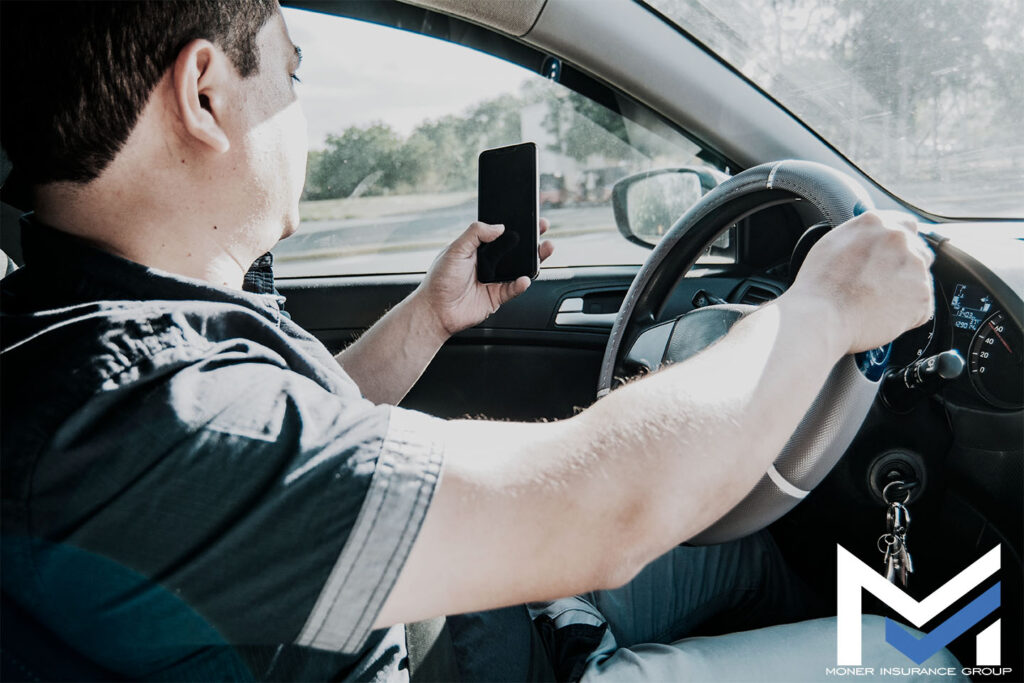As with everything in this economy, the premiums for auto insurance in Texas are increasing in line with the rate of inflation. However, there’s one thing that will cause a significant spike in your premium—an at-fault accident.
At-fault accidents can occur due to several various circumstances. However, when it comes to the stats not only with auto insurance in Texas but nationwide—distracted driving is one of the most common factors responsible for these accidents.
Distracted driving encompasses all types of activities that take your focus and your eyes off the road ahead of you. While the most common activity documented in accidents resulting from distracted driving is texting on a device—there’s more to being a safe driver than not texting.
There are dozens of distractions that can take a person’s focus off of their driving:
- Talking on the phone, even when using Bluetooth
- Eating or drinking
- Talking to passengers
- Grooming (yes, people drive while applying makeup or shaving on the way to work)
- Reading, including focusing on Google Maps instead of the road
- Adjusting the radio
- Kids arguing in the backseat
The list could go on forever, but you get the idea—as drivers, we can easily be distracted and distracted drivers could end up paying higher premiums. Why?
Because distracted driving causes thousands of accidents every year and a significant number of them result in fatalities or serious injury.
The good news?
These accidents are 100% preventable if you are vigilant about safe, focused driving. When you are vigilant, you can avoid these accidents which can save lives. But, additionally, it can help keep your premiums for auto insurance in Texas from spiking due to an at-fault accident on your record.
How To Identify A Distracted Driver
It’s not that hard to spot a habitual driver, you don’t always have to even see the actual driver. In fact, you can often tell a distracted driver by some key behaviors on the road such as:
- Crossing in and out of adjacent lanes
- Driving severely under the speed limit
- Indecisive lane changes or turns
- Constantly changing rate of speed
Ironically, one of the other forms of unsafe driving that exhibits these characteristics is drunk driving. Distracted driving can end up being just as fatal as drunk driving when an accident occurs. So, if you make it a habit to call 911 on drunk drivers, then you may have actually been dealing with a distracted driver.
However, what if you are one of these distracted drivers? Think it could never be you because you can “multitask?” If we’re all being honest with ourselves, the odds are very high that we have all been a “distracted driver” at some point and time.
Don’t Think It Could Never Be You
Distracted drivers come from all walks of life, occupations, and lifestyles, and drive many kinds of vehicles. It only takes a single call you answer on the road, two kids fighting in the back, or simply daydreaming to become one yourself.
So, before you say, “I can send a text, or take an important business call and still be focused on the road,” the stats don’t lie. Think about these stats from the National Safety Council and U.S. Department of Transportation. They document the physical and financial impact distracted driving has caused:
- Distracted driving leads to 1.6 million accidents per year
- Nearly 400,000 injuries every year from distracted driving accidents
- Over 3,000 fatalities caused by distracted driving
- Responsible for an average increase of 20% on premiums for auto insurance in Texas since 2011
The statistics show solid evidence that younger drivers have the highest instances of distracted driving. Teens lead that demographic as the NHTSA data shows in terms of fatal crashes from distracted driving—teens overwhelmingly lead in that category. However, that doesn’t mean adult drivers aren’t losing focus on the road either.
It all comes down to being a responsible driver and focusing on practicing some practical safe-driving habits.
Safe Driving Habits 101
With the evolution of smart technology in mobile devices and even in-vehicle systems, the potential for distractions is higher than ever. That doesn’t mean you can’t practice safe, focused driving. You just need to focus on some basic safety protocols behind the wheel:
- Leave The Phone Alone: This means no texting or talking while driving, even with hands-free devices, you’re still distracted. If it’s an emergency, pull over somewhere safe, take or make the call and then get back on the road.
- Don’t Try To Eat on The Go: Not only is scarfing down your lunch while doing 70 mph down the freeway dangerous—it’s unhealthy. Take the time out of your day to eat your food in the proper setting, or at least in your care while parked. Making this a habit also means you won’t make a mess of yourself when you hit a pothole while navigating fries and ketchup.
- Have Your Route Mapped Out: Navigation systems are very intuitive these days. One thing they can’t do though, is make you use them more safely. Messing around with Google Maps or your car’s nav system while driving can negate the point of the route. Plan your route ahead of time, load it into your navigation system or pull over if needed.
- Make Focused Driving A Family Activity: Talk to your family about focused driving habits and their importance. When the whole family is on board with focused driving, it makes it easier to follow the protocols.
- Be Aware Of Other Drivers: Even if you’re doing great and practicing focused driving—be on the lookout for other drivers that aren’t. Always be vigilant and you won’t get caught off guard.
Safe Drivers Save On Auto Insurance In Texas
Many carriers will give you a significant discount based on how safely you drive. Carriers like Progressive and Safeco offer voluntary monitoring that rewards you with premium discounts for safe driving.
At Moner Insurance Group, we are committed to getting the best coverage available for safe drivers seeking auto insurance in Texas. Contact us today and see how much your safe driving habits can save you on your premium! You could be leaving significant discounts on the table with your current policy.

